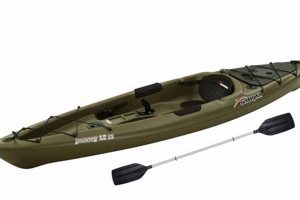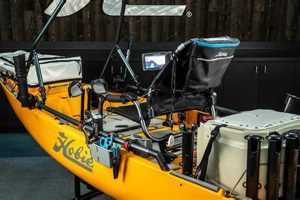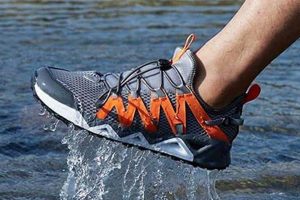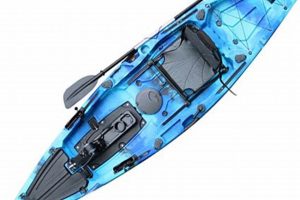This specialized angling method involves paddling and fishing from a kayak while wearing a waterproof garment designed for immersion in cold water. This protective suit allows anglers to continue fishing comfortably in conditions that would otherwise be prohibitive due to low temperatures or risk of capsizing.
The practice expands fishing opportunities throughout the year, particularly in colder climates or during shoulder seasons. Enhanced safety is a significant advantage, as the suit provides insulation and flotation in the event of an accidental submersion. This capability allows anglers to explore more challenging waters and target species unavailable during warmer months. Historically, cold-water angling from small, non-motorized craft required specialized knowledge and gear. Modern materials and manufacturing techniques have made this activity more accessible, enabling a wider range of individuals to experience this unique form of fishing.
Further exploration of this topic will cover key aspects such as suitable kayak selection, essential drysuit features, appropriate fishing techniques, and recommended safety precautions.
Essential Tips for Drysuit Kayak Angling
Preparation and awareness are critical for a safe and successful outing. The following recommendations address key aspects of this specialized fishing method.
Tip 1: Dress Appropriately for Immersion. Underneath the drysuit, wear multiple layers of insulating, non-cotton clothing. This layering system manages moisture and provides warmth even if the drysuit leaks or is compromised.
Tip 2: Conduct a Pre-Trip Drysuit Check. Before each trip, inspect the drysuit for any signs of damage, including tears, punctures, or zipper malfunctions. Ensure gaskets are supple and properly seated.
Tip 3: Practice Essential Safety Procedures. Develop proficiency in self-rescue techniques, including re-entry and roll practice. Carry essential safety gear, such as a paddle float, bilge pump, and communication device.
Tip 4: Choose a Stable Kayak Platform. Opt for a kayak design known for stability, especially in challenging conditions. Consider features like a wide beam and a sit-on-top configuration.
Tip 5: Plan for Cold-Water Conditions. Understand the effects of cold water on the human body. Pack extra layers, warm drinks, and high-energy snacks to combat hypothermia.
Tip 6: File a Float Plan. Inform someone on shore of your intended route, estimated return time, and emergency contact information.
Tip 7: Check Weather Forecasts and Water Conditions. Avoid venturing out in adverse conditions, including strong winds, high waves, or rapidly changing weather patterns. Be aware of currents, tides, and potential hazards.
Adhering to these guidelines enhances angler safety, preparedness, and overall enjoyment. A proactive approach to risk management allows for a more focused and fulfilling experience on the water.
By understanding the unique demands of this activity, anglers can confidently explore new fishing opportunities while mitigating potential hazards.
1. Drysuit Selection and Fit
Appropriate drysuit selection and fit are paramount for safe and comfortable drysuit kayak fishing. A properly fitted drysuit provides essential protection from cold water and enhances mobility while paddling and fishing. An ill-fitting suit can restrict movement, compromise thermal protection, and increase the risk of leaks. The following facets highlight key considerations for selecting and fitting a drysuit for kayak angling.
- Material and Construction
Drysuits constructed from breathable, waterproof fabrics offer superior comfort and performance. Durable, abrasion-resistant materials are essential for withstanding the rigors of kayak fishing environments. Features like reinforced seams and waterproof zippers contribute to overall suit integrity and longevity. Choosing a material appropriate for the expected water temperatures is critical for thermal management.
- Fit and Sizing
A drysuit should fit snugly but allow for a full range of motion required for paddling and casting. Overly tight suits restrict movement and can compromise circulation, while excessively loose suits can trap cold water and reduce thermal efficiency. Proper gasket fit at the wrists and neck is essential to prevent water ingress. Trying on various sizes and styles is crucial for determining the optimal fit.
- Features and Accessories
Relief zippers, integrated socks, and adjustable wrist and ankle seals enhance comfort and convenience. Pockets, attachment points, and internal suspenders provide storage options and improve overall functionality. Consider features like reinforced elbows and knees for added durability. The choice of features will depend on individual needs and preferences.
- Maintenance and Care
Proper maintenance extends the lifespan and performance of a drysuit. Rinsing the suit with fresh water after each use removes salt and debris. Storing the suit in a cool, dry place away from direct sunlight prevents premature deterioration. Regular inspections for damage and timely repairs are essential for maintaining the suit’s waterproof integrity.
Careful consideration of these factors ensures a drysuit provides optimal protection and comfort during kayak fishing excursions. A properly selected and maintained drysuit enhances angler safety and enjoyment, allowing for greater focus on the fishing experience. Neglecting any of these aspects can compromise both performance and safety, potentially leading to discomfort or even hazardous situations on the water.
2. Cold Water Safety Procedures
Cold water safety procedures are inextricably linked to drysuit kayak fishing. Immersion in cold water presents significant risks, including hypothermia and cold water shock. These physiological responses can rapidly incapacitate even strong swimmers, underscoring the critical role of appropriate safety measures. Drysuits, while offering protection, are not fail-safe. Leakage, zipper failure, or capsizing can lead to cold water exposure. Therefore, understanding and practicing specific safety procedures is paramount. For instance, a kayaker who capsizes in cold water without proper self-rescue skills and appropriate safety equipment faces immediate danger, even while wearing a drysuit. Conversely, a kayaker prepared with self-rescue techniques, a paddle float, and knowledge of cold water survival strategies significantly increases their chances of a safe outcome in a similar scenario.
Essential cold water safety procedures encompass several key areas. Pre-trip planning, including checking weather forecasts and informing someone of the intended route, is fundamental. Wearing appropriate insulating layers beneath the drysuit enhances thermal protection. Carrying essential safety gear, such as a VHF radio, whistle, and signaling devices, increases the chances of rescue. Practicing self-rescue techniques, including re-entry and roll practice, builds confidence and proficiency in handling capsize situations. Understanding the symptoms and treatment of hypothermia equips anglers to respond effectively in emergencies. Regularly inspecting and maintaining drysuit integrity minimizes the risk of leaks and failures.
Ultimately, meticulous attention to cold water safety procedures is not merely a recommendation but a prerequisite for responsible drysuit kayak fishing. These procedures mitigate inherent risks associated with cold water immersion and significantly enhance angler safety. Integrating these practices into every outing fosters a culture of preparedness and responsible decision-making, ensuring the experience remains enjoyable and safe, rather than hazardous. Challenges such as changing weather conditions and unexpected equipment failures highlight the importance of ongoing vigilance and adaptation. A comprehensive understanding of these principles empowers anglers to make informed decisions, minimize risks, and enjoy this specialized activity responsibly.
3. Appropriate Kayak Choice
Kayak selection significantly impacts safety and effectiveness in drysuit kayak fishing. Stability is paramount due to the added weight and bulk of a drysuit, especially during casting, landing fish, or re-entry after a potential capsize. Sit-on-top kayaks generally offer greater stability and self-rescue capabilities compared to sit-inside models, making them a preferred choice for cold-water conditions. A wider beam and a flatter hull contribute to primary stability, reducing the likelihood of tipping. Kayak length influences maneuverability and tracking; shorter kayaks are more agile in tight spaces, while longer kayaks track better in open water. Consideration of intended fishing locations, such as sheltered bays versus open ocean, informs appropriate kayak length. For instance, a shorter, more maneuverable kayak proves advantageous in confined mangrove environments, whereas a longer, seaworthy kayak is better suited to coastal expeditions. Additionally, sufficient storage capacity for fishing gear, safety equipment, and extra clothing is crucial for longer trips or colder conditions. A kayak equipped with dedicated rod holders, tackle storage compartments, and dry hatches streamlines fishing operations and protects essential gear from the elements. Neglecting careful kayak selection compromises safety and effectiveness, hindering the overall fishing experience.
Matching kayak characteristics to the angler’s skill level further enhances safety and performance. Beginners benefit from stable, user-friendly kayaks with forgiving handling characteristics, while experienced paddlers might prefer higher-performance designs optimized for speed and maneuverability. Weight capacity considerations extend beyond the angler’s body weight to encompass the combined weight of the drysuit, fishing gear, and any additional equipment. Exceeding the kayak’s weight capacity negatively impacts stability and performance, increasing the risk of capsize. Selecting a kayak with ample weight capacity ensures safe and efficient operation, even with a fully laden vessel. Furthermore, certain kayak features, such as rudder systems or pedal-powered propulsion, enhance control and maneuverability, particularly in challenging conditions like strong currents or wind. These features allow anglers to maintain position and focus on fishing, rather than constantly battling to control the kayak. Practical considerations, such as transportation and storage, also influence kayak choice. Inflatable or foldable kayaks offer portability advantages, while rigid kayaks generally provide superior performance and durability. Balancing portability needs with performance requirements ensures the chosen kayak aligns with individual circumstances and logistical constraints.
Ultimately, appropriate kayak selection directly correlates with angler safety, comfort, and overall fishing success. A well-chosen kayak functions as a stable and efficient platform, enabling anglers to navigate diverse water conditions, manage essential gear, and focus on the fishing experience. Ignoring these considerations compromises both safety and effectiveness, potentially transforming a rewarding outing into a hazardous or frustrating endeavor. Careful evaluation of individual needs, skill level, intended fishing locations, and environmental conditions ensures a harmonious balance between kayak characteristics and angler requirements. This understanding optimizes both performance and safety, maximizing enjoyment and minimizing risks associated with drysuit kayak fishing.
4. Essential Fishing Gear
Specialized fishing gear enhances effectiveness and safety in drysuit kayak fishing. Equipment choices directly influence an angler’s ability to target specific species, manage challenging conditions, and respond to unexpected situations. Careful consideration of these factors optimizes performance and preparedness on the water.
- Rods and Reels
Shorter, more robust rods facilitate maneuverability within the confines of a kayak. Selecting rod and reel combinations appropriate for target species and fishing techniques maximizes efficiency. For example, a shorter, heavier rod paired with a high-capacity reel proves advantageous for battling larger fish in strong currents, whereas a lighter setup suits finesse fishing for smaller species. Appropriate rod and reel selection directly influences casting accuracy, line management, and overall fishing success.
- Tackle and Lures
Tackle selection aligns with target species and prevailing conditions. Lures, flies, or bait choices depend on the specific fish sought and local regulations. Carrying a diverse selection of lures and terminal tackle allows anglers to adapt to changing conditions or target multiple species. For instance, brightly colored lures attract fish in murky water, while more natural patterns prove effective in clear conditions. Organized tackle storage within the kayak facilitates efficient lure changes and minimizes wasted time.
- Safety Equipment
Essential safety equipment extends beyond standard kayak fishing gear in cold-water environments. A VHF radio enables communication in emergencies, while a personal locator beacon (PLB) provides an additional layer of security in remote locations. A well-stocked first-aid kit addresses minor injuries, and a signaling device, such as a mirror or flare, aids in attracting attention if needed. These items contribute significantly to angler safety, particularly in the event of capsize, injury, or unexpected changes in weather conditions.
- Specialized Accessories
Specialized accessories streamline fishing operations from a kayak. A fish finder assists in locating fish and identifying underwater structures, increasing fishing efficiency. Rod holders secure rods while paddling or landing fish, preventing loss or damage. A landing net simplifies the process of bringing fish onboard safely. These accessories, while not strictly essential, enhance angling effectiveness and overall enjoyment. For example, a well-placed rod holder allows an angler to quickly grab a rod when a fish strikes, rather than fumbling through gear.
Careful selection and organization of essential fishing gear enhances both safety and effectiveness in drysuit kayak fishing. Each element contributes to the angler’s overall preparedness and ability to respond effectively to diverse situations. Prioritizing essential safety equipment safeguards against unforeseen circumstances, while appropriate rod, reel, and tackle choices optimize fishing performance. Ultimately, a well-equipped angler enjoys a safer and more productive experience on the water. For example, an angler equipped with a fish finder can quickly locate promising fishing spots, while an angler with appropriate safety gear can confidently navigate challenging conditions, knowing they are prepared for potential emergencies.
5. Weather and Water Conditions
Weather and water conditions exert a profound influence on drysuit kayak fishing safety and feasibility. Cold air and water temperatures increase the risk of hypothermia, demanding heightened vigilance regarding thermal protection and appropriate safety procedures. Wind strength and direction significantly impact kayak control and paddling efficiency, particularly in exposed areas. Strong winds can create challenging paddling conditions, increase the risk of capsize, and hinder navigation. Wave height and frequency further complicate navigation and increase the potential for swamping or capsizing. Currents, tides, and water temperature fluctuations influence fish behavior and dictate appropriate fishing techniques. For example, strong tidal currents necessitate heavier tackle and adjusted drift fishing strategies, while sudden drops in water temperature can trigger changes in fish feeding patterns. Ignoring these dynamic factors compromises safety and diminishes fishing success.
Real-world scenarios illustrate the direct impact of weather and water conditions. A sudden shift from calm conditions to strong offshore winds can quickly carry a kayak far from shore, posing a serious risk if the angler is unprepared for self-rescue or lacks appropriate communication equipment. Unexpectedly encountering cold water upwelling can accelerate the onset of hypothermia, even with a drysuit, highlighting the importance of proper layering and understanding cold water survival strategies. Similarly, changing tidal currents can create unpredictable water movement around structures, necessitating adjustments in kayak positioning and fishing techniques. Accurate weather forecasting and real-time observation of water conditions are crucial for informed decision-making and dynamic adaptation to changing circumstances. Accessing reliable marine weather forecasts, understanding local weather patterns, and observing subtle shifts in wind, waves, and currents enable anglers to anticipate potential hazards and adjust plans accordingly. This proactive approach minimizes risks and maximizes the probability of a safe and successful fishing experience.
A comprehensive understanding of weather and water conditions is essential for responsible drysuit kayak fishing. Integrating this knowledge into pre-trip planning, on-the-water decision-making, and emergency preparedness protocols mitigates inherent risks associated with this activity. Respecting the dynamic nature of these elements empowers anglers to make informed choices, adapt to changing circumstances, and prioritize safety while pursuing this demanding yet rewarding form of fishing. Failure to acknowledge and respond appropriately to prevailing conditions jeopardizes not only fishing success but, more importantly, angler safety. Continuous awareness and informed decision-making are cornerstones of a safe and enjoyable experience.
Frequently Asked Questions
This section addresses common inquiries regarding drysuit kayak fishing, providing concise yet informative responses to facilitate a deeper understanding of this specialized activity.
Question 1: What are the primary advantages of using a drysuit for kayak fishing?
Drysuits provide immersion protection in cold water, extending the fishing season and enhancing safety in the event of capsize. They offer superior insulation compared to wetsuits or dry tops, allowing anglers to comfortably fish in lower temperatures.
Question 2: Are drysuits necessary for all kayak fishing excursions?
Drysuit necessity depends on water temperature, air temperature, and personal preference. In cold water conditions where hypothermia is a risk, drysuits become essential safety equipment. In warmer climates, they offer added protection but might not be required for all situations. Angler experience and comfort level also factor into the decision.
Question 3: How does one select the appropriate drysuit for kayak fishing?
Proper fit, material breathability, and features like relief zippers and gaskets are crucial considerations. Durability and abrasion resistance are essential for withstanding the rigors of the kayak fishing environment. Suit selection should align with expected water temperatures and individual mobility needs.
Question 4: What essential safety precautions should be taken when kayak fishing in a drysuit?
Carrying appropriate safety gear, such as a paddle float, bilge pump, and communication device, is paramount. Practicing self-rescue techniques and understanding cold water survival strategies are crucial for mitigating risks associated with cold water immersion.
Question 5: How does kayak selection influence safety and performance in drysuit kayak fishing?
Kayak stability and storage capacity are essential considerations. A stable platform with ample storage for gear and safety equipment enhances both angler comfort and preparedness. Kayak choice should align with the angler’s skill level, intended fishing location, and anticipated water conditions.
Question 6: What specific fishing gear or techniques enhance effectiveness when kayak fishing in a drysuit?
Shorter fishing rods, specialized tackle appropriate for target species, and fish finders enhance efficiency. Adapting fishing techniques to prevailing conditions and utilizing appropriate gear for cold-water environments maximizes fishing success and ensures angler safety.
Understanding these key aspects of drysuit kayak fishing promotes safe and successful outings. Preparation, appropriate equipment selection, and adherence to safety protocols contribute significantly to a positive experience on the water.
Further sections will delve into advanced techniques and specific gear recommendations to optimize drysuit kayak fishing experiences.
Conclusion
Drysuit kayak fishing presents unique opportunities and challenges. Safe and successful participation hinges on a thorough understanding of equipment selection, safety procedures, and environmental awareness. From drysuit fit and maintenance to kayak choice and specialized fishing gear, each element plays a critical role in mitigating risks and maximizing the effectiveness of this demanding pursuit. Consistent attention to weather and water conditions, coupled with a proactive approach to safety, empowers anglers to navigate dynamic environments and respond effectively to unforeseen circumstances. Ultimately, informed decision-making and meticulous preparation are cornerstones of a rewarding and safe drysuit kayak fishing experience.
Continued exploration and refinement of techniques within this specialized field promise further advancements in both safety and performance. As technology evolves and understanding of cold-water environments deepens, opportunities for enhanced angler preparedness and experience will continue to emerge. Responsible engagement with this activity necessitates ongoing learning, adaptation, and a steadfast commitment to safety. This dedication ensures the preservation of this unique pursuit for future generations of anglers seeking to explore the rewarding challenges of drysuit kayak fishing.






